|
|
|
|
|
|
|
|
|
|
|
WELCOME TO THE IMAGES PAGE OF THE SOUTHWEST INSTITUTE FOR SPACE RESEARCH
|
|
|
 |
The images on this page were taken with the telescope shown on the left, a Meade LX-200 12-inch (30 cm) Schmidt-Cassegrain, with a Meade Pictor 416XTE CCD camera. Most of the images were taken during the course of the Southwest Institute's research program on near-Earth asteroids and comets. This page will be updated on a semi-regular basis as additional images are taken.
Disclaimer: since most of the images on this page have been taken primarily for scientific purposes we have not felt it necessary to subject them to any kind of extensive image processing. Thus, for the most part the images are somewhat "noisy" and are not as "pretty" as they perhaps could be. From time to time we may post some processed images for aesthetic purposes, but this will not be a high-priority activity.
|
|
|
|
Disclaimer: As can be seen in the above photograph, the telescope is currently situated on an alt-azimuth mount. Thus, field rotation becomes an issue in some of the longer-exposure images. This is especially apparent in some of the "stacked," or co-added, images. When a permanent site is located for the telescope it will be equatorially mounted and this problem should disappear.
Added January 16, 2001: The Institute has now acquired a field-derotator for its telescope, so field rotation should no longer be a problem for future images.
Added April 12, 2001: We have now begun testing the CCD with a second telescope, a Meade LX-200 8-inch (20 cm) Schmidt-Cassegrain. This instrument, which is much more portable than the main 30-cm telescope, is well-suited for field observations (e.g., the Africa solar eclipse in June 2001) and for on-site educational activities. This page will now contain occasional images obtained with this instrument as well as with the main telescope.
Added February 7, 2003: For most of the past two years almost all of our images have been taken with the 20 cm telescope, and the 30 cm telescope has been idle. However, once we have the property acquired for the Earthrise Project, and have received the necessary funding, the permanent mounting and siting of the 30 cm telescope is one of our top priorities. The background in the above photo shows some of the Earthrise property, and more photos of this site are shown on the Earthrise page.
Added January 13, 2005: During 2004 we found it necessary to upgrade both our telescope and the controlling computer, and to switch to a new camera as well. Although we do occasionally utilize the system for important observations and have the capability of obtaining critical data if something urgent comes up, for the time being we are primarily focused upon developing the property for Earthrise and thus our research and imaging program is in a state of quasi-hiatus. Once Earthrise is operational we expect to resume our program in full force. At the bottom of this page are some test images we took with the new telescope in September 2004.
View latest images
|
|
|
|
|
Left: multiple images of the near-Earth asteroid 1998 SF36, taken on March 22, 2001. The given times by the individual images are Universal Time. At the time these images were taken the asteroid was 0.049 AU (4.6 million miles, or 7.3 million km) from Earth, enroute to a closest approach of 0.038 AU (3.5 million miles, or 5.7 million km) on March 29. |
|
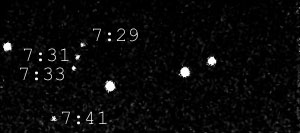 |
|
| 1998 SF36 was discovered in September 1998 by the LINEAR program. It is an especially important asteroid in that it is currently the primary planned destination of the joint Japanese/American MUSES-C asteroid rendezvous and sample return mission, scheduled for launch in late 2002. Precise measurements of its position during its current close approach from images like these are used in refining calculations of its orbit, which in turn will aid significantly in navigating the MUSES-C probe toward its destination.
UPDATE: As a result of data obtained via images such as these, the orbit of 1998 SF36 has now been well enough determined to allow it to be assigned a permanent number, (25143). It has also now been given the name Itokawa. MUSES-C, now renamed Hayabusa, was successfully launched on May 9, 2003, and is now scheduled for arrival at Itokawa in July 2005.
|
|
|
|
|
At left is an image of Comet 19P/Borrelly, obtained on the morning of September 27, 2001, with the 20-cm telescope. This was the comet that was encountered by the Deep Space 1 spacecraft on September 22; images from that encounter can be viewed here. The bright "jets" of material seen coming off the comet's nucleus in the Deep Space 1 images are helping to form the bright "anti-tail" that is visible extending to the lower left of the comet's central region in this image. |
|
|
|
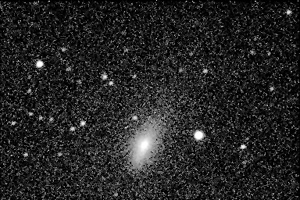 |
|
|
|
At left is a series of "stacked" exposures (total exposure time 8 minutes) of Comet LINEAR C/2000 WM1, obtained with the 20-cm telescope on October 12, 2001. This comet may become a fairly bright object near the end of 2001, possibly becoming visible to the unaided eye. More information about this comet is contained on the recent comets page. |
|
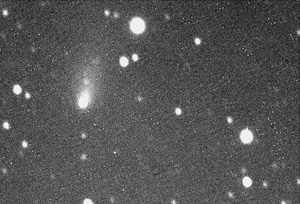 |
|
|
|
|
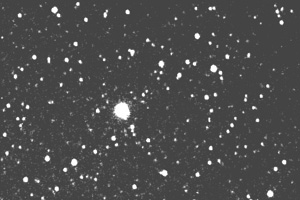 |
|
|
|
|
 |
|
| LEFT: Two-minute exposure of Comet Petriew P/2001 Q2, obtained on August 23, 2001, with the 20-cm telescope. This comet was discovered by Canadian amateur astronomer Vance Petriew on the morning of August 18, and on the following morning the Southwest Institute became the first institution in the world to obtain accurate positional information for it. Comet Petriew passed perihelion on September 1, 2001, at a distance of 0.95 AU from the sun; it has an orbital period of only 5.5 years and, theoretically, can make close approaches to Earth. RIGHT: Image of Nova Sagittarii 2001 No. 2 (also known as V4739 Sagittarii), obtained on the evening of August 26, 2001, confirming the discovery made a few hours earlier by Portuguese amateur astronomer Alfredo Pereira. (The nova is the very bright star just left of center.) The nova reached a peak brightness of 7th magnitude but thereafter faded rapidly from view. |
|
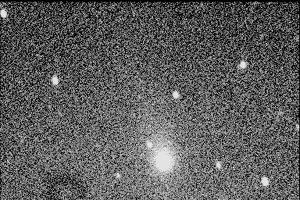 |
|
At left is an image of Comet P/Honda-Mrkos-Padjusakova (also known as 45P) taken with the 20-cm telescope on April 17, 2001. The contrast has been enhanced to bring out the faint tail. This comet has an orbital period of 5.3 years, but the current return is unfavorable for observations; it was about 10th magnitude, and 30 degrees from the sun, when this image was taken. |
|
| Comet 45P is very interesting in that it occasionally comes close to Earth; for example, it passed 0.17 AU from Earth at the previous return in 1995-6. Two returns from now, it passes only 0.060 AU (5.6 million miles, or 9.0 million km) from Earth on August 15, 2011, and during the return after that it passes 0.083 AU (7.8 million miles, or 12.5 million km) from Earth on February 11, 2017. Images taken during the current return, and any that might be taken during the very unfavorable return in 2006, will help in refining predictions for the upcoming close encounters. |
|
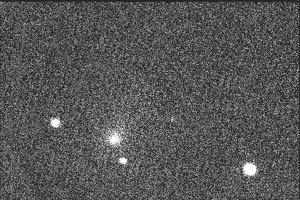 |
|
|
 |
|
|
|
|
20-second exposure of the main-belt asteroid (4151) Alanhale, taken on February 13, 2001. Alanhale orbits the sun with a period of 5.6 years; it was at perihelion (2.71 AU from the sun) on December 29, 2000, and was near opposition (1.73 AU from Earth) when this exposure was taken, and thus was about as close to Earth, and as bright, as it can ever get. The slightly diffuse object to Alanhale's lower left is an over-exposed image of the galaxy UGC 5400. |
|
| Image of Comet Tuttle-Giacobini-Kresak (also known as 41P) taken on November 30, 2000. At the time the comet was in outburst and was as bright as 11th magnitude. This comet has an orbital period of 5.4 years, and passes only 0.136 AU (12.6 million miles, or 20.4 million km) from Earth on March 27, 2017. |
|
|
|
|
At left is an image of the globular star cluster M70 in Sagittarius, obtained on August 28, 2000. Comet Hale-Bopp was discovered on July 23, 1995, when it was located very close to M70. Unfortunately, there did not seem to be any comets around when this exposure was taken . . .
However . . .
|
|
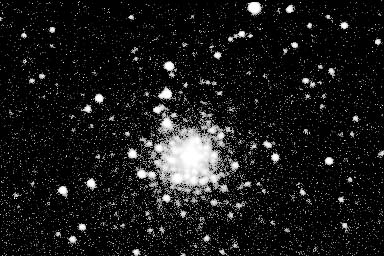 |
|
|
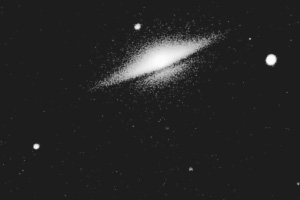 |
|
|
|
|
|
|
|
|
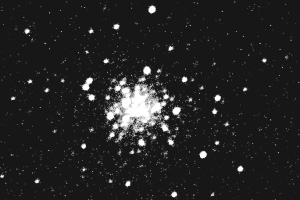 |
|
| "First night" images obtained with the 20 cm telescope, obtained on April 12, 2001. At left is the spiral galaxy M104 in Virgo, at right the globular cluster M68 in Hydra. Both images are 30-second exposures. |
|
|
|
One of the faintest comets we've been following lately is Comet P/2001 R1, discovered by the LONEOS program in September 2001. It has an approximate orbital period of 6.5 years, and would ordinarily be a very obscure object just like the many other comets that are being discovered all the time, except for one thing: on January 10, 2002 Comet LONEOS passed only 0.014 AU (1.3 million miles, or 2.1 million km) from Mars. For comparison, the closest confirmed cometary approach to Earth -- which took place back in 1770 -- was 0.015 AU. |
|
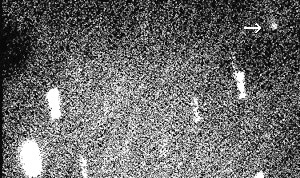 |
|
| The above image was made from a series of 5 two-minute exposures of Comet LONEOS taken on January 14, 2002, just four days after its closest approach to Mars. This is a very "noisy" image, partially because of scattered light due to zodiacal light and to Mars itself; the contrast has been enhanced to bring out the comet's faint tail. The stars appear as streaks due to the comet's motion throughout the period of time the exposures were being taken. |
|
|
|
|
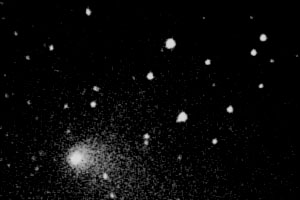 |
|
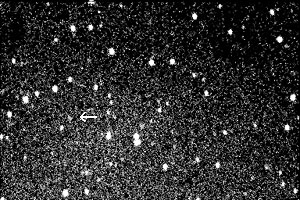 |
|
|
|
|
|
| LEFT: The Southwest Institute was one of the first institutions in the world to obtain accurate positional information for Comet Snyder-Murakami C/2002 E2, discovered on March 11, 2002, by Doug Snyder in Arizona and by Shigeki Murakami in Japan. This image was taken with the 20-cm telescope on March 13. The comet, about 11th magnitude at discovery, had already passed perihelion on February 21, at 1.47 AU from the sun. RIGHT: The faintest comet we've observed so far is C/2002 B1, discovered by LINEAR on January 26. This image is a 3-minute exposure obtained with the 20-cm telescope on the evening of March 14; the comet was about 17th magnitude. This Comet LINEAR passes perihelion on April 19, at 2.27 AU from the sun; it has an orbital period of 31 years.
|
|
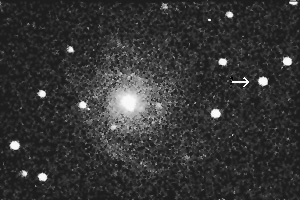 |
|
 |
|
| LEFT: One of the brightest supernovae in recent years appeared in the galaxy M74 in Pisces, and was discovered on January 29, 2002, by Japanese amateur astronomer Yoji Hirose. In early February it became almost as bright as 12th magnitude. This image is a one-minute exposure taken on the evening of February 8. RIGHT: The "asteroid" 2001 TX16 was discovered by LINEAR in October 2001. It is traveling in a distinctly cometary orbit (approximate orbital period 6.8 years) and, moreover, has made some close approaches to Jupiter during the recent past; it is thus quite possible that, despite its asteroidal appearance, 2001 TX16 may be an extinct (or possibly dormant) comet. At the Southwest Institute we've been observing it regularly to see if it might be exhibiting any cometary activity. The above image is a combined image of 10 one-minute exposures, obtained on February 13, 2002; even when this is examined under enhanced contrast the appearance is entirely asteroidal. For now, at least, 2001 TX16 remains classified as an asteroid.
|
|
|
 |
|
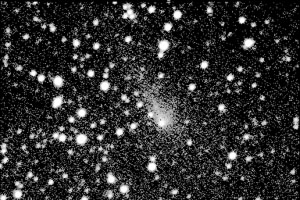 |
|
|
|
|
| In contrast to 2001 TX16, one of the other "cometary" asteroids we've been following, 2001 OG108 (discovered on July 28, 2001 by the LONEOS program) has in fact turned out to be a comet. LEFT: in this image obtained on October 9, 2001 (and, indeed, for the next several months) the object appears completely stellar. RIGHT: the object appears distinctly cometary in this image obtained on March 13, 2002. Comet LONEOS was at perihelion on March 15, 2002 (0.99 AU from the sun), and passes 0.55 AU from Earth on April 17; it has an orbital period of approximately 48 years.
|
|
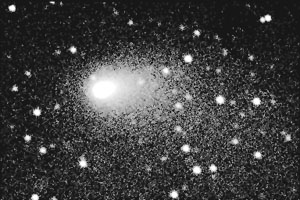 |
|
|
|
|
|
| At left is our most recent image of Comet LINEAR C/2000 WM1, obtained on March 15, 2002. Further information about and additional images of this comet can be found on our recent comets page. |
|
|
At left is a "stacked" series of five images (total exposure time nine minutes) of Comet 7P/Pons-Winnecke, taken on June 13, 2002. The comet's overall brightness was 12th magnitude; a faint tail a few arcminutes long can be seen to the upper left (roughtly westward). This comet made several close approaches to Earth during the early 20th Century, including one to 0.039 AU (3.6 million miles, or 5.8 million km) in 1927. Its present orbit does not bring it close to the earth, however future changes in its orbit will create some additional close approaches in the late 21st Century, the closest of these being 0.17 AU in 2062. |
|
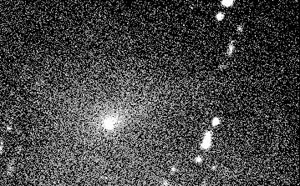 |
|
|
|
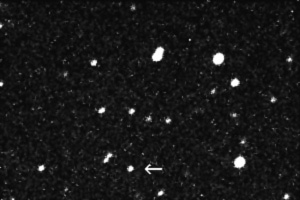 |
|
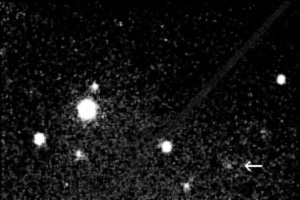 |
|
|
|
| LEFT: The Earth-grazing asteroid 2002 NY40, imaged on August 12, 2002, when it was 0.074 AU (6.9 million miles, or 11.1 million km) from Earth. On August 18 it passed only 0.0036 AU (330,000 miles, or 530,000 km) -- 1 1/3 times the moon's distance -- from our planet. RIGHT: Comet NEAT C/2001 Q4, imaged (two-minute exposure) near the beginning of dawn on August 12, 2002. It is currently located over 7 AU from both the sun and Earth, and thus is a relatively faint object of 16th magnitude; however during the spring of 2004 it has the potential to be a conspicuous naked-eye object. More information about this comet can be found on the recent comets page. |
|
|
Most recent images |
|
|
|
|
|
|
|
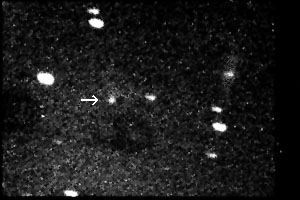 |
|
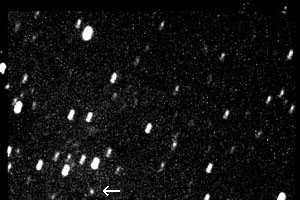 |
|
| Comet NEAT C/2001 Q4 (left) and Comet LINEAR C/2002 T7 (right), both imaged with the 20 cm telescope on December 1, 2002. Both comets may become prominent naked-eye objects in early to mid 2004, and are described on the recent comets page.
|
|
|
|
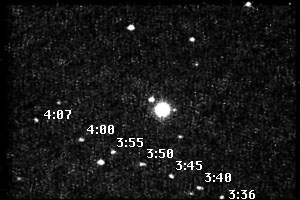 |
|
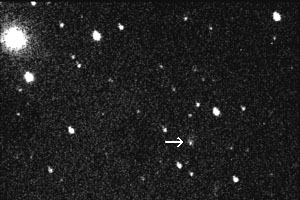 |
|
| LEFT: In March 1998 the asteroid 1997 XF11 -- now assigned number (35396) -- made headlines when early calculations showed it would be passing extremely close to Earth in October 2028, although later calculations have moved the "miss distance" then out to a relatively "safe" 0.0062 AU (580,000 miles, or 934,000 km) -- still a close call, in astronomical terms. In late 2002 this asteroid passed 0.064 AU (5.9 million miles, or 9.5 million km) from Earth, its closest approach until the 2028 encounter. This image is a series of "stacked" images (each 30 seconds long) taken on November 5, 2002, a few days after its closest approach. (Times are in Universal Time.) RIGHT: Comet 81P/Wild 2, the destination of the Stardust comet sample return mission. This image was taken December 6, 2002, with the 20 cm telescope. Stardust will encounter Comet P/Wild 2 in January 2004, and return the collected samples to Earth two years later.
|
|
|
|
|
|
 |
|
 |
|
| Images of Comet Kudo-Fujikawa C/2002 X5, independently discovered by Japanese amateur astronomers Tetuo Kudo and Shigehisa Fujikawa. The comet passed perihelion on January 29, 2003, at a relatively small 0.19 AU from the sun. In mid-January it reached 6th magnitude, and for a week in late January was visible in the field of view of the coronagraphs aboard SOHO. LEFT: Image taken with the 20 cm telescope on December 15, two days after the comet's discovery. This was one of the images utilized for early orbital calculations. Assisting in the observations that morning was 5th-Grade student Tyler Hale, who is credited in the calculations issued from the Minor Planet Center (see observatory code 921). RIGHT: Image from the LASCO C3 coronagraph aboard SOHO, taken on January 26. (Among the stars in the field are Alpha and Beta Capricorni.) This image was taken from the SOHO web page.
|
|
|
|
At left is our most recent image of the Stardust comet (81P/Wild 2), taken on the evening of April 28, 2003, as it was passing by the Crab Nebula (M1) in Taurus. The field was located low in the western sky right after dusk, and thus this was a difficult image to obtain. For a while this image was featured on the Stardust web page.
Comet Wild 2 is now hidden behind the sun, and does not become visible again until right around the time of the Stardust encounter in January 2004.
|
|
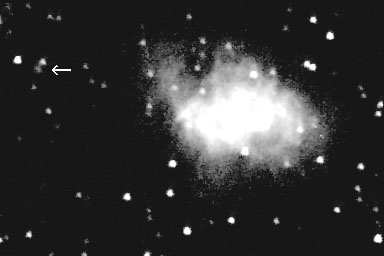 |
|
|
|
|
|
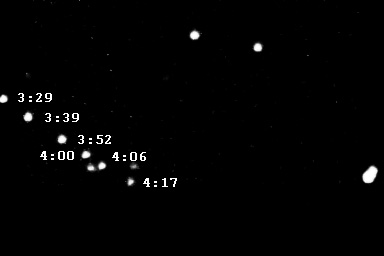 |
|
|
|
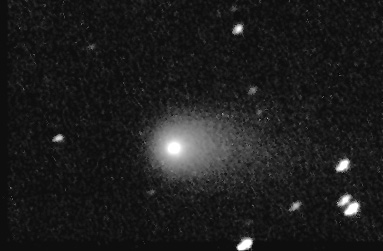 |
|
|
TEST IMAGES WITH THE NEW 20-CM TELESCOPE. LEFT: Comet Machholz C/2004 Q2 (discovered in August by California astronomer Don Machholz), on September 23, 2004. By the end of 2004 Comet Machholz had become a rather easy naked-eye object. Perihelion passage is on January 24, 2005, 1.21 AU from the sun. RIGHT: The near-Earth asteroid (4179) Toutatis on September 22, 2004, one week before its close approach to Earth (0.0103 AU, or 1.54 million km, or 960,000 miles). |
|
|
|
The "asteroid" (944) Hidalgo, on January 14, 2005. Hidalgo was discovered in 1920, and travels in a distinctly comet-like orbit (period 13.7 years) that carries it out almost to the orbit of Saturn. There has been much speculation that Hidalgo might be an extinct or dormant comet, and the image here (11 combined images for a total exposure time of 5.25 minutes) was obtained one week before perihelion to see if Hidalgo might be showing any cometary activity. |
|
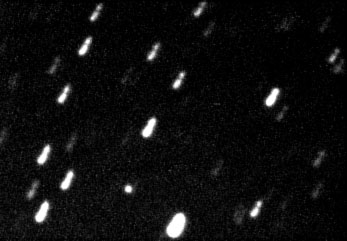 |
|
| Hidalgo (in lower left center) is entirely stellar in this image, and still appears stellar when examined under very high contrast. We had hoped to obtain a longer series of exposures, but problems with the system (still under shakedown) kept us from getting onto Hidalgo earlier in the night. |
|
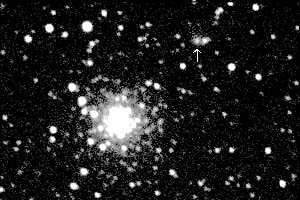 |
|
DEJA VU ALL OVER AGAIN: Sometimes it pays to return to the scene of the crime. On July 23, 1995, Comet Hale-Bopp was discovered when Alan Hale and Thomas Bopp were (independently of each other) observing the globular star cluster M70 in Sagittarius. On the night of July 1-2, 2003, another comet was near M70, but this was an already-known object: Comet 65P/Gunn, discovered in 1970, and having an orbital period of 6.8 years. The image at left in a one-minute exposure taken with the 20 cm telescope at 11:35 P.M. MDT on July 1. |
|
|
|
Back to near-Earth asteroid page
Back to Southwest Institute main page
|
|
|
|
|
|
|
|
|
|
|
|
|
|
|
|
|
|
|
|
|
|
|
|
|
|
|
|
|
|
|
|
|
|
|
|
|
|
|
|
|
|
|
|
|
|
|
|
|
|
|
|
|
|
|
|
|
|
|
|
|
|

































